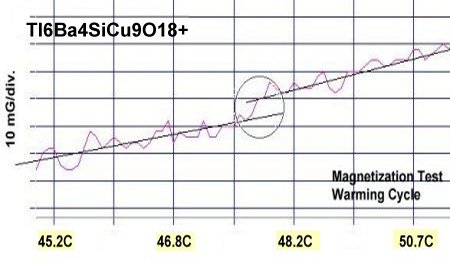
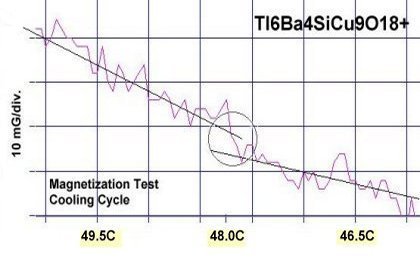


Superconductors.ORG herein reports the discovery of two new room-temperature superconductors with record high transitions near 48 Celsius (118F, 321K) and 44 Celsius (111F, 317K). The chemical formulas of these materials are Tl6Ba4SiCu9O18+ and Tl5Ba4SiCu8O16+ respectively. These are the ninth and tenth superconductors found to have transition temperatures above room temperature1.
Since dozens of new superconductors have already been found through the application of planar weight disparity (PWD) along the "C" axis,
an effort was made to further increase the unit cell size and planar weight ratios (PWR) of materials already producing
extraordinarily high transition temperatures. In the first compound, barium (Ba) was substituted into the tin (Sn) atomic sites of
the 42 C superconductor discovered in September. This produced a 44 Celsius critical transition
temperature (shown below right). Then, in the second compound, the lattice was expanded to near 33 Angstroms by inserting another Tl and another
CuO2 layer. This altered the structure from a D212 to an F212 (shown below left). That material produced a
record Meissner transition near 48 Celsius.
The plots at page top show diamagnetic transitions for both warming and cooling test
cycles. The diamagnetic shift is on the order of 6 to 8 milli-Gauss. This is weaker than with prior
discoveries, due to a lower volume fraction (VF) of superconductive material within the bulk. The straight lines
illustrate the average of the noise component, skewing apart at Tc.
Above is a plot showing a Meissner transition near 44 C for the compound
Tl5Ba4SiCu8O16+. Because of its higher volume fraction, it has a stronger
transition of around 15 milli-Gauss.
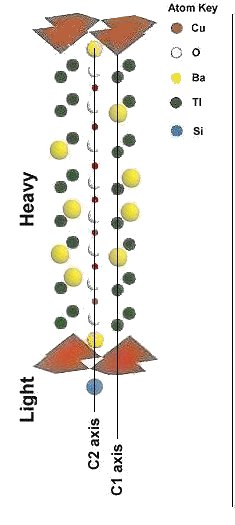
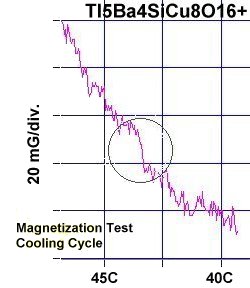
Barium was chosen as a substitute for both tin (Sn) and lead (Pb) because it is also divalent. It also adds mass to the upper part of the structure, increasing the planar weight ratio above that of tin, without lowering the elasticity modulus to the level of lead. The heavy (upper) region of the unit cell is optimally hole-doped at 25% in the 48C compound.
Of nine unambiguous magnetization tests, the transitions ranged from a low of 48.0 C up to a high of 50.2 C. The average of all nine tests was 48.8 Celsius.2 Below are the two plots with the lowest and highest temperature transitions.
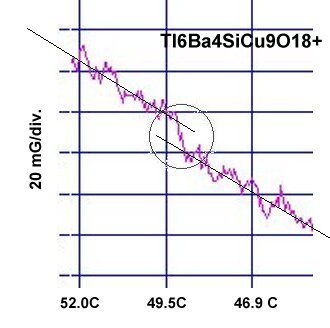
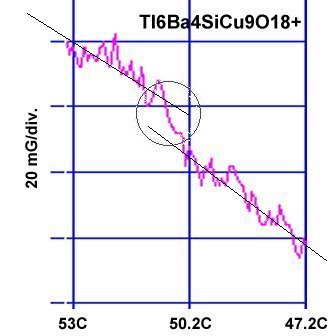
The below graph shows how Tc has increased in proportion to the planar weight ratio along the (heavy) C1 axis. Those dots outside the grid are all above room temperature.
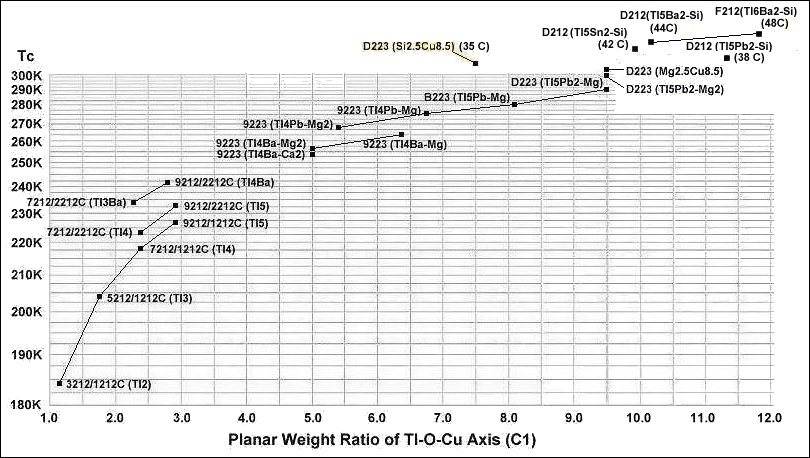
These two quinary compounds were synthesized using the layer cake method, as shown below. The pellet had over 100 interference layers. And, even using this layering technique, the volume fraction is low, requiring very sensitive test equipment.
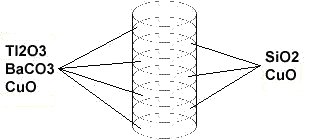
Stoichiometric ratios of the below chemicals were used for the ODD layers:
Tl2O3 99.99% (Alfa Aesar) (2.5 or 3 mols)...and quasi-stoichiometric amounts of the below for the EVEN layers.
SiO2 99.996% (GE 214) (7 mols)The chemical precursors were pelletized at 60,000 PSI and sintered for 42 hours at 860C. The pellet was then annealed for 10+ hours at 500C in flowing O2. Temperature was determined using an Omega type "T" thermocouple and precision OP77 DC amplifier. The magnetometer employed twin Honeywell SS94A1F Hall-effect sensors with a tandem sensitivity of 50 mv/Gauss.
RESEARCH NOTE: The copper-oxides are strongly hygroscopic. All tests should be performed immediately after annealing.
RE-PUBLICATION NOTICE: Elsevier Publishing, dba Elsevier Science, as well as Morris Communications, both print and broadcast divisions, are specifically prohibited from re-publishing any part of this news story.
E. Joe Eck
© 2013 Superconductors.ORG
All rights reserved.
1. Materials 5, 6 and 8 have not yet been published, pending patent application.
2. Testing temperatures are believed accurate within +/- 0.50 degrees C.
 BACK to "News" page at Superconductors.ORG
BACK to "News" page at Superconductors.ORG